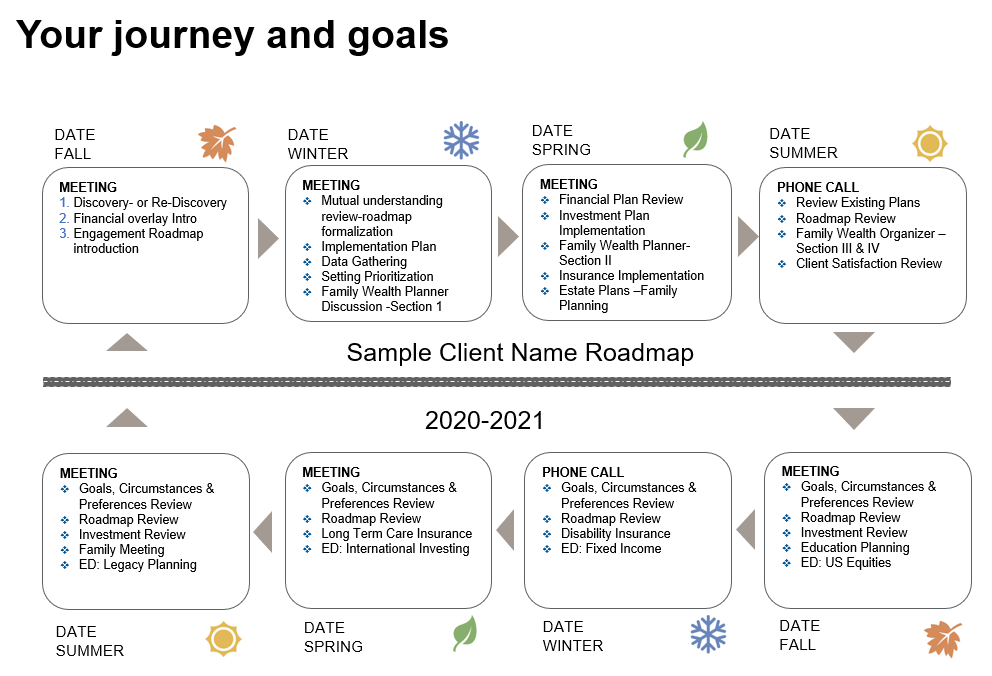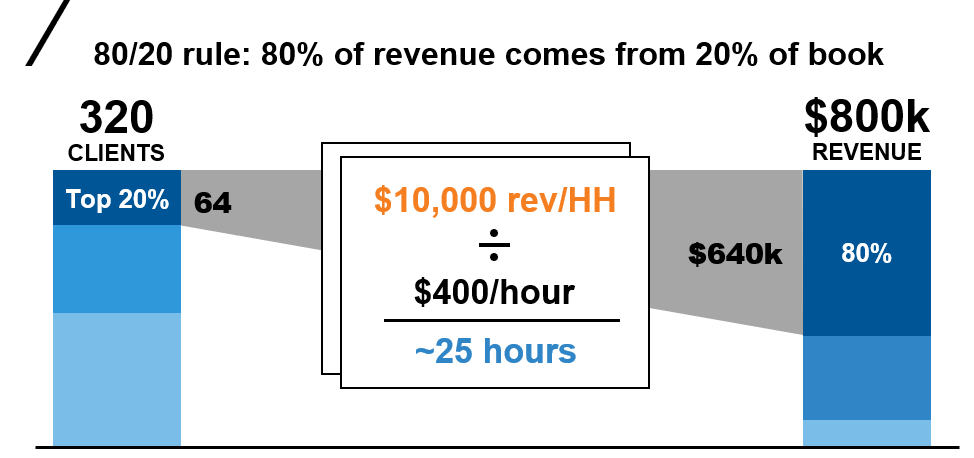How do financial advisors grow NOW? We believe it’s through exceptional service
There was once an entrepreneur named Jack who decided to enter the rental car business. Jack had 17 cars and they weren’t any different than his major competitors. Jack was unable to obtain coveted airport locations because they were occupied. Other companies had millions of cars and hundreds of locations. From every angle, it seemed as though Jack was at a disadvantage. But he was determined to offer his customers one thing above his competitors—better service than they had ever experienced before.
Armed with this single differentiator, Jack worked tirelessly to gain market share. Decades later when he died, Jack’s rental car business was worth more than his competitors combined. This company was named after the battleship Jack was stationed on when he was in the military, the U.S.S. Enterprise.1
We believe exceptional client service is the path to growth
There are many parallels between Jack’s story and that of a financial advisor. Like Jack, who offered non-differentiated cars, financial advisors offer strikingly similar portfolios. Many advisors recite the same value proposition (“we help you meet your financial goals…” or “we create a customized financial plan…”). On the surface, there does not seem to be much difference between one financial advisor and another.
So, how do you differentiate yourself as an advisor? We believe you differentiate yourself by delivering exceptional client service, like Jack did with Enterprise.
The cornerstone of exceptional client service
The cornerstone of exceptional client service is ongoing, scheduled contact. Let me tell you a story about an advisor I know.
Tim had a problem. Tim’s book of business consisted of approximately 400 client accounts, most of which were brokerage accounts. He began transitioning the brokerage accounts to advisory under the guise that they would get a better experience. But with less focus on selling products, Tim had stopped calling his clients altogether.
Tim eventually came to a critical realization. An annuitized revenue model without consistent, ongoing implementation of the financial plan is just a more expensive brokerage account. For Tim, the first few months with each client were wonderful. He would talk about their goals and have great conversations about helping them. But then the plan would stagnate, and the relationship would stall. Over time, his clients failed to perceive how this more expensive advisory relationship was different from the cheaper brokerage one.
We suggested that Tim combine his financial plans with a client roadmap (illustrated below). This created ongoing scheduled contact where he would break the financial plan down into different components, allowing Tim to address each component of the plan separately. Instantly, things began to change.
For illustrative purposes only.
Map your client engagement
Clients got it. They finally understood the plan was being followed and they appreciated the service they were getting from Tim. They started giving him more of their money to manage because he was doing great work and ensuring they knew about it. Regularly scheduled implementation justified Tim’s ongoing fee. The adoption of client roadmaps and scheduled contact gave his service model structure and subsequently created organic growth.
The non-negotiables of delivering exceptional client service
There’s one flaw with this plan—time. You probably don’t have enough time to do financial plans and roadmaps for every client … or do you? Below is a guide I use with advisors to help them create the time.
1. 5/50 rule is the new 80/20 rule
You’ve heard that 80% of your production comes from 20% of your clients.
Click image to enlarge
HH = households. Source: These numbers represent a real book of business consisting of 320 clients and $800,000 of revenue. This example was selected since the allocation of revenue across the client base is representative of a significant number of clients that Russell Investments has worked with in the context of our coaching program. Your numbers may differ from these. This information may not be representative of the experience of other clients and is no guarantee of future performance or success.
But do you know the 5/50 rule? 5% of your revenue comes from the bottom 50% of your book.
Click image to enlarge
HH = households. Source: These numbers represent a real book of business consisting of 320 clients and $800,000 of revenue. This example was selected since the allocation of revenue across the client base is representative of a significant number of clients that Russell Investments has worked with in the context of our coaching program. Your numbers may differ from these. This information may not be representative of the experience of other clients and is no guarantee of future performance or success.
Another advisor I worked with, George, experienced the 5/50 rule firsthand. George managed over 600 client accounts or households. George’s practice was extremely reactive.He found himself constantly putting out fires and responding to urgent requests. His inability to manage his time and capacity caused great frustration. George knew that something had to change in order to grow the business and control the feeling of being overwhelmed with reactive tasks.
When George sat down to analyze his book, he discovered that his top 33 client households (approx. 100 accounts) accounted for 91% of the revenue coming into the practice.The more significant realization, though, was that the remaining 531 households only represented 9% of the revenue, or $39,000 dollars of the $435,000 in total practice revenue. George recognized the need to segment his clients and optimize his time.
We believe the first non-negotiable of delivering exceptional client service is segmentation. If you do not analyze where your revenue is coming from, you will not be able to optimize how your time is being spent.
You have to allocate the appropriate amount of time, while still delivering on the outcomes you’ve promised. This is only possible by first segmenting your practice.
2. Optimize your time through outsourcing
At Russell Investments we have been working with advisors for over 30 years. In that time, we have analyzed thousands of advisors’ practices. In this year’s Value of an Advisor study, the data has shown a particular uptick in the value that advisors deliver through behavioral coaching. The topic is highly relevant to the increased volatility we’ve seen in markets in 2020.
We endorse model strategies, specifically because we believe a well-structured model portfolio is the best investment solution for investors and the best business solution for advisors. When advisors spend less of their precious time building portfolios from scratch, we believe they get more time to spend in the two areas where they provide the most value: client outcomes and relationships.
Outsourcing does not mean that you are giving up the value asset management brings to the relationship.It simply means that value is being redefined.By outsourcing investment management (asset allocation, rebalancing, tax loss harvesting, manager due diligence, etc.) advisors can decrease the time spent on investments and research. This surplus can be used to allocate toward client engagement and service. This reallocation enhances the level of service for the client. This heightened service likely causes additional assets to flow to the advisor.
Outsourcing is the second non-negotiable of delivering exceptional service. It also allows you to prioritize client service by delivering client roadmaps through scheduled contact. We believe your ability to connect the investment management to the client’s ability to accomplish their outcomes creates exceptional client service.
The bottom line
Remember Jack from Enterprise. He had 17 cars with zero differentiation when he started. He had no meaningful advantage over his competitors. But he endeavored to do one thing differently: provide better service to his customer. In doing so he took an ordinary business and made it extraordinary.
The path to delivering exceptional client service starts with segmenting your book to understand where your revenue is coming from. Then, outsourcing key operations which will allow you to spend more time implementing client roadmaps. This combination will help to elevate the client’s experience. When you elevate the client’s experience, your practice will likely experience organic growth.
We can help you make an honest assessment of the service and value you are delivering to your clients. The improvements you make to your client service and engagement model will likely be the most impactful to your clients and to your business.
1 Buffett, Warren. “Remarks by Warren Buffett.” Lecture. Goldman Sachs 10,000 Small Businesses Summit. April 30th, 2018.
2 Rob Knapp, The Supernova Advisor (Hoboken, New Jersey, John Wiley & Sons, 2008), page 32.


